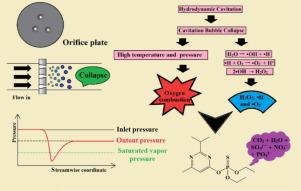Process Safety and Environmental Protection ( IF 7.8 ) Pub Date : 2021-07-17 , DOI: 10.1016/j.psep.2021.07.026 Boqian Li 1 , Shu Li 1 , Ludong Yi 2, 3 , Haosheng Sun 1 , Jun Qin 1 , Jun Wang 1, 2 , Dawei Fang 2, 4

|
Diazinon (DZN), a broad-spectrum and highly effective organophosphorus pesticide, is widely being used in agricultural production and household environments. However, massive DZN effluent can be generated during the DZN production process, which will cause devastating effects on the ecosystem and damage human health due to the improper dispose of pesticide effluent before discharging. In this work, hydrodynamic cavitation (HC), a new advanced oxidation technology, was used to degrade DZN in wastewater for the first time. The influences of DZN initial concentration (5.0–15 mg/L), solution pH (4.0–10), temperature (30–50 °C) and some orifice plate geometric parameters (orifice numbers and orifice half angles) on the degradation effect of DZN were investigated. It can be observed that the DZN in solution can be effectively degraded in orifice plate HC system based on three orifices with 45° convergent half angle and the degradation ratio can reach 50.52 % under the operation conditions of 150 min treatment time, 30 °C temperature and pH = 4.0 acidity. Subsequently, the studies of intensifying DZN degradation were also carried out through adding different inorganic oxidants such as potassium peroxodisulfate (K2S2O8), potassium periodate (KIO4) and sodium perchlorate (NaClO4). The maximum DZN HC degradation extent (81.92 %) can be achieved in the presence of K2S2O8 under the optimized conditions. The generated intermediate products in DZN HC degradation process are some low-toxic and low-active substances. And that, these intermediate products can be further mineralized to H2O, CO2 and inorganic ions. On the basis of cavitational yield, the energy consumption analysis has been performed. Overall, this work demonstrates that the HC combined with oxidant K2S2O8 may be a promising strategy for the large-scale treatment of organophosphorus pesticide wastewater.
中文翻译:

水动力空化降解有机磷农药二嗪农的参数优化及机理研究
二嗪农(DZN)是一种广谱高效的有机磷农药,被广泛应用于农业生产和家庭环境中。然而,在DZN生产过程中会产生大量DZN废水,由于农药废水在排放前处理不当,会对生态系统造成破坏性影响,损害人类健康。在这项工作中,水力空化 (HC) 是一种新的高级氧化技术,首次用于降解废水中的 DZN。DZN初始浓度(5.0-15 mg/L)、溶液pH(4.0-10)、温度(30-50 °C)和一些孔板几何参数(孔数和孔半角)对降解效果的影响DZN 进行了调查。可以观察到,在基于45°会聚半角的三个孔板的孔板HC系统中,溶液中的DZN在150 min处理时间、30°C温度的操作条件下可以有效降解,降解率可达50.52%。和 pH = 4.0 酸度。随后,还通过添加不同的无机氧化剂如过二硫酸钾(K2 S 2 O 8 )、高碘酸钾 (KIO 4 ) 和高氯酸钠 (NaClO 4 )。在优化条件下,在存在 K 2 S 2 O 8 的情况下,DZN HC 的最大降解程度(81.92%)可以达到。DZN HC降解过程中产生的中间产物是一些低毒、低活性的物质。并且,这些中间产物可以进一步矿化为H 2 O、CO 2和无机离子。在空化产量的基础上,进行了能耗分析。总的来说,这项工作表明 HC 与氧化剂 K 2 S 2 结合O 8可能是大规模处理有机磷农药废水的一种有前景的策略。



























 京公网安备 11010802027423号
京公网安备 11010802027423号